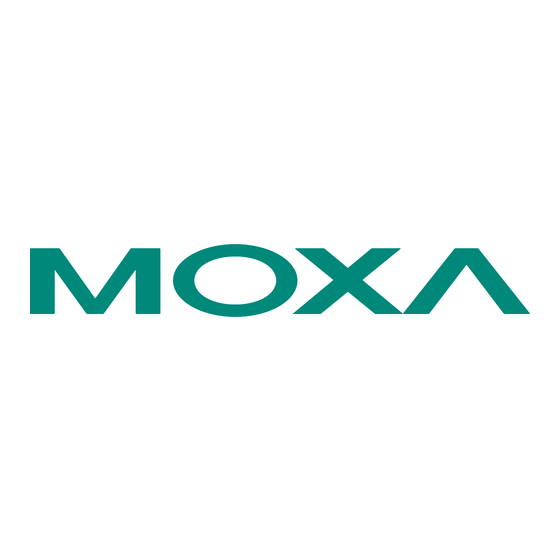Advertisement
Quick Links
Fig. 2: DB9 to Fiber Converter Side Panels
2. Switch Settings
The two side panels of the Converter contain a total of four sets
of DIP Switches (abbreviated SW)—labeled RS485 WIRING,
DB9 CONFIG, STANDARD CONFIG, and RESISTOR—that
are used to configure the various data transmission modes. The
proper configuration of each of these four sets of DIP Switches
is described below:
• STANDARD CONFIG
For selecting serial port protocol: RS-232 or RS-485/422.
RS232:
RS-232 protocol/connection, default.
485/422:
RS-485/422 protocol/connection.
• RS485 WIRING
For selecting between 2-wire and 4-wire RS-485.
2wire:
2-wire at half-duplex mode.
4wire:
4-wire at full-duplex mode, default.
• DB9 CONFIG
232:
RS-232/DB9 connection, default.
485/422:
RS-485/422 via DB9 port
NOTE: The STANDARD CONFIG and DB9 CONFIG DIP
Switch settings must agree. Either set both to RS-232, or set
both to RS-485/422.
For DB9 model and port connection, the available
connections by the three SW settings are:
Protocol &
STANDARD
DB9 CONFIG
Connection
CONFIG SW
SW
RS-232
RS232
232
4-wire RS-485
485/422
485/422
2-wire RS-485
485/422
485/422
RS-422
485/422
485/422
• RESISTOR SW
(Terminal Resistor/Pull-up and Pull-Down Res. Setting)
The RESISTOR SW is used for RS-485/422 protocol/connection,
and takes effect when STANDARD CONFIG is at "485/422".
RESISTOR SW default:
RX-TERM ON:
TX-TERM ON:
P-DOWN ON:
P-UP ON
Note:
The way in which the termination and P-UP, P-DOWN resistors
are set up depends on the RS-485/422 network configuration.
•
Ensure that the copper cable and its voltage polarity match
the device requirements for a 4-wire or 2-wire connection.
•
Improper termination and network configuration will cause
the devices to work poorly.
•
When thee Rx-TERM & TX-TERM switches are enabled,
both P-Down & P-Up DIP switches should be on as well.
• DB9 Connector for Copper Wires
RS485
WIRING SW
RS-232 protocol/connection via DB9
---
4wire
Unused 6
2wire
Unused 7
Unused 8
4wire
Unused 9
RS-232 Cable Connection via DB9
RXD
TXD
GND
RS-485/422 protocol/connection via DB9
1, 2, 3, 4. All are at "OFF"
Enables 130Ω terminator on RX
Enables 130Ω terminator on TX
Enables 1 KΩ pull down on
RS422 TXor
RS485(2-wire)TX/RX-
: Enables 1 KΩ pull up on
RS422 TX+ or
RS485(2-wire)TX/RX+
1 Unused
2 RS-232 RXD
3 RS-232 TXD
4 Unused
5 Signal Ground
2
3 TXD
3
2 RXD
5
5 GND
If you use DB9 for an RS-485/422 cable connection, the Pin
definition and assignments are as follows:
1 RS-485/422 TX- or RS-485(2-wire) TX/RX-
Unused 6
2 RS-485/422 TX+ or RS-485(2-wire) TX/RX+
Unused 7
3 RS-485/422 RX+
Unused 8
4 RS-485/422 RX-
Unused 9
5 Signal Ground
You may configure RESISTOR SW for proper termination or
P-UP, P-DOWN resistors for the network connection.
Copper Wire
Fiber Optic Wire
TX
RX
TX
RX
Fig. 5: RS-485/422/232 Fiber Optic Network Connection
3. LED Description
ACT
Optic Fiber Port
RS485/422/232 Port
TX
F
DB9 or
C
Terminal Block
RS-485/422/232
PWR
Fiber Media Converter
Fig. 6: RS-485/422/232 to ST Fiber Converter Front Panel
LED
Color
Function
F (FX ACT)
Green
Blinks when fiber data is received
Blinks when Copper data is
C (Copper ACT) Green
received
Lit when +5V power is coming up
PWR
Green
RS-232
RS-422
RS-485
DB9 or
Terminal
Block
RS-485/422/232
DB9, Terminal
Fiber Converter
RX
Advertisement

Subscribe to Our Youtube Channel
Summary of Contents for Moxa Technologies TCF-141-S
-
Page 1: Switch Settings
• RESISTOR SW If you use DB9 for an RS-485/422 cable connection, the Pin definition and assignments are as follows: (Terminal Resistor/Pull-up and Pull-Down Res. Setting) 1 RS-485/422 TX- or RS-485(2-wire) TX/RX- Unused 6 2 RS-485/422 TX+ or RS-485(2-wire) TX/RX+ Unused 7 3 RS-485/422 RX+ Unused 8... -
Page 2: Package Checklist
20Km TCF-141-S DB9(male) 1310 or up to 20 km (using single-mode fiber). The TCF-141-S (TCF- Fig. 7: DC+5V Input Jack and Dimensions mode 141-M) Converter is equipped with a multiple interface circuit that can handle RS-232, RS-422, and RS-485 serial interfaces.

















Need help?
Do you have a question about the TCF-141-S and is the answer not in the manual?
Questions and answers